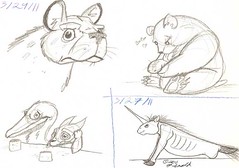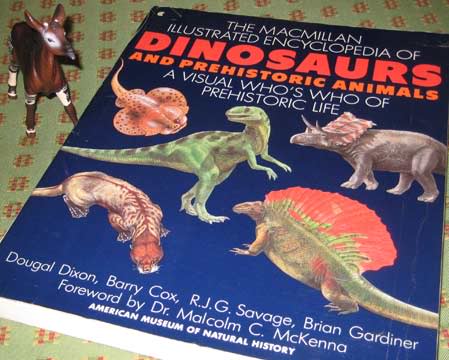
When I was but a wee lass in the early 1990's, I lusted after what I thought would be the be-all and end-all of prehistoric animal books: The Macmillan Illustrated Encyclopedia of DINOSAURS and Prehistoric Animals. The many, many authors - including our old friend Dougal Dixon - are listed on the front cover. The illustrators are Colin Newman, Steve Kirk, Malcolm Ellis, Graham Allen, Andrew Robinson, Andrew Wheatcroft, Steve Holden, Vana Haggerty, and "Grundy & Northedge".
It's a little hard to explain the magnitude of this book in my imagination at the time. Information about prehistoric creatures wasn't as readily available as it is today (remember, the very idea of using a computer for anything other than writing essays and playing "Tetris" was absurd). I associate this book with the crazy times just after "Jurassic Park" - I don't even recall buying this book (at, according to the lovingly preserved price tag, the Museum of Science gift shop for $24.95) until maybe 1996.
So imagine my amazement when I finally looked at the publication information this time: it's copyright 1988 by Marshall Editions Limited. In other words, as I've mentioned before, this is a book from that incredibly awkward time immediately after Bob Bakker published The Dinosaur Heresies (it has just occurred to me that every time I mentioned Heresies, I assume it doesn't need an introduction to the audience I've built up. I know you guys). The difference is that it is one of the few fully illustrated books from that time.
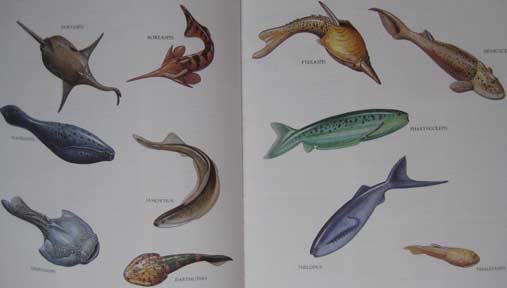
And the scope of the book is ambitious as hell: every fossil vertebrate found to date, given a loving life reconstruction. Naturally, the dinosaurs command all the attention, but we'll talk about them (well, technically most of them...) on Friday. They are, however, hardly the most interesting animals in the book. Honestly, even in 1988 there was already a ton of ink spilled on the new theories of dinosaurs -- and almost no popular natural history books explaining the strange fish you see before you on these pages. Really, this book often just made me more curious about animals I'd never heard of and frustrated because there was (and still is, frankly) little information to be found, and that's what we'll focus on today and Wednesday.
A word about the format of this book: it follows a format I've seen in some other natural history books: Two pages of full-color illustrations followed by two pages with maybe a paragraph or two of information about the animal, where and when it lived, what it ate, and (in an act of arguable redundancy) what it looked like. And this is sad, because some of the animals demand to be elaborated upon.
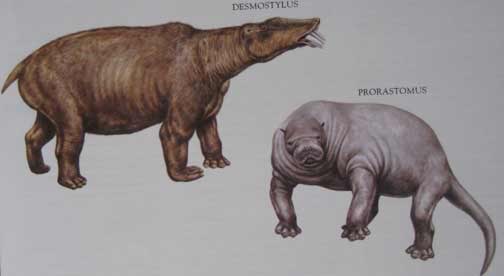
None more than Desmostylus. Holy cow, look at that thing! The book helpfully explains that "it must have looked and acted like a modern hippo", when what I really long for is a skeletal study with a detail of that strange head and some idea of what (if any) modern animal it's related to.
The same goes for the Prorastomus, simply identified as an "early Sirenian". The book also notes that this reconstruction is mostly speculative, leading us to wonder why a manatee ancestor would have such a skinny tail and big burly hind legs. Really, I would love to see an updated field guide to fossil mammals, since some of them are begging for attention.
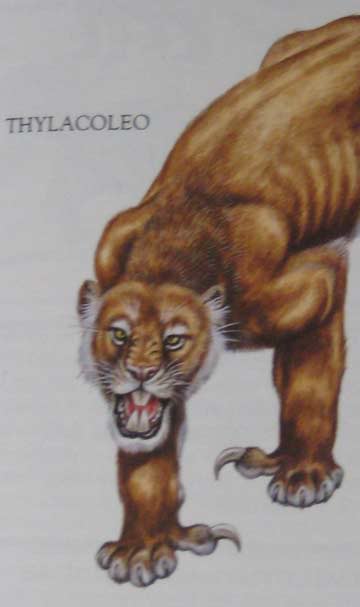
Like Thylacoleo. He's described here as a "marsupial lion". What that means is that he is a marsupial from Australia that converged onto big cats, much like the comparatively less obscure Thylacosmilus from South America and the remarkably dog-like Tasmanian Thylacene. Thylacoleo really did have sharp, fang-like incisors, though they probably weren't as goofy as they look here. What I'm wondering about here are those giant thumb-claws; it's like the real-life equivalent of all those fictional species on DeviantArt who have "Raptor claws" for some dang reason.
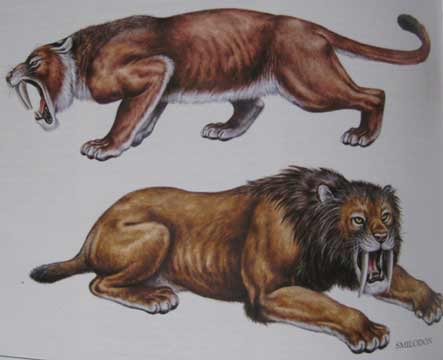
As for the real cats, I like how the famous Smilodon is just chillin', rocking a bad-ass lion mane. Eusmilus, the sabretooth above him, looks like he is ready to murder everyone.
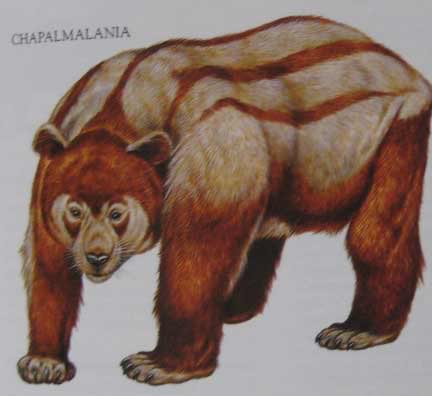
Prehistoric mammals don't readily lend themselves to gaudy color schemes, since, all evidence from DeviantArt aside, there aren't many gaudy colorful mammals running around today (that were actually born that way, like with purple fur and such). The Macmillan Encyclopedia does what it can, though. This is Chapalmalania, who is described as a giant... raccoon. Because back in '88, there was still a lot of debate as to whether Panda Bears were indeed bears or some kind of giant raccoon. I have no idea where this leaves our poor StripeyBear today.
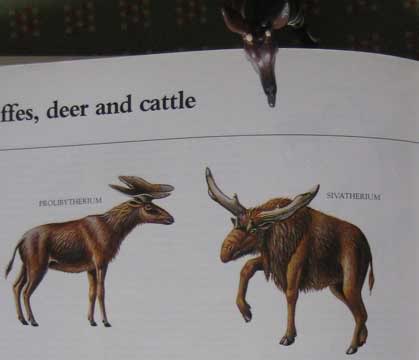
Often in the Encyclopedia, you'll have illustrations of a plethora of extinct animals that look nothing like their more familiar modern relatives and one or two that do. I'm glad they avoided that for the giraffes.
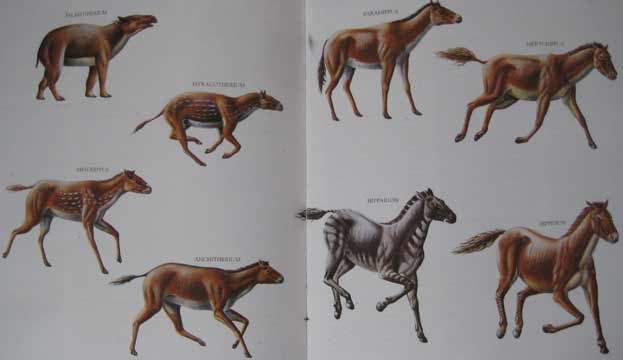
Here's your Semi-Requisite Early Horse Sequence.
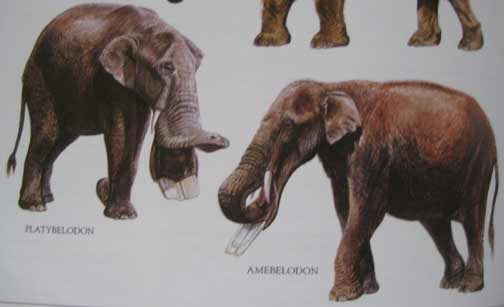
And a pair of "shovel-tuskers". I've always found these elephants fascinating, and I regret not giving them a proper tribute when the opportunity came up earlier this year.
Now, up until this point the paintings have been in a fairly consistent style.
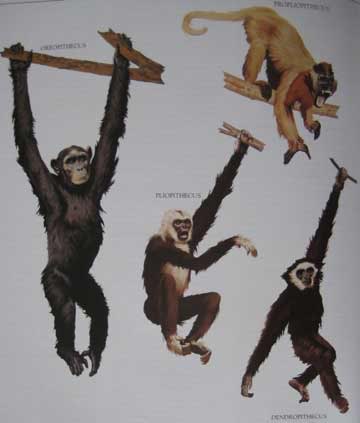
But then there is a sudden art shift when we hit the primates. Who knows why, and from the look of it, that Propliopithecus in the upper-right corner thinks of nothing but sex and violence all day.
Been a little unusually mammal-biased today, haven't I? Well, I'll focus on a wider variety of animals in the next post. Until then, think of nothing but sex and violence all day; it's and old primate tradition after all.
On to Part Two!
----
Sketch of the Day!
Random coffeeshop animals:
